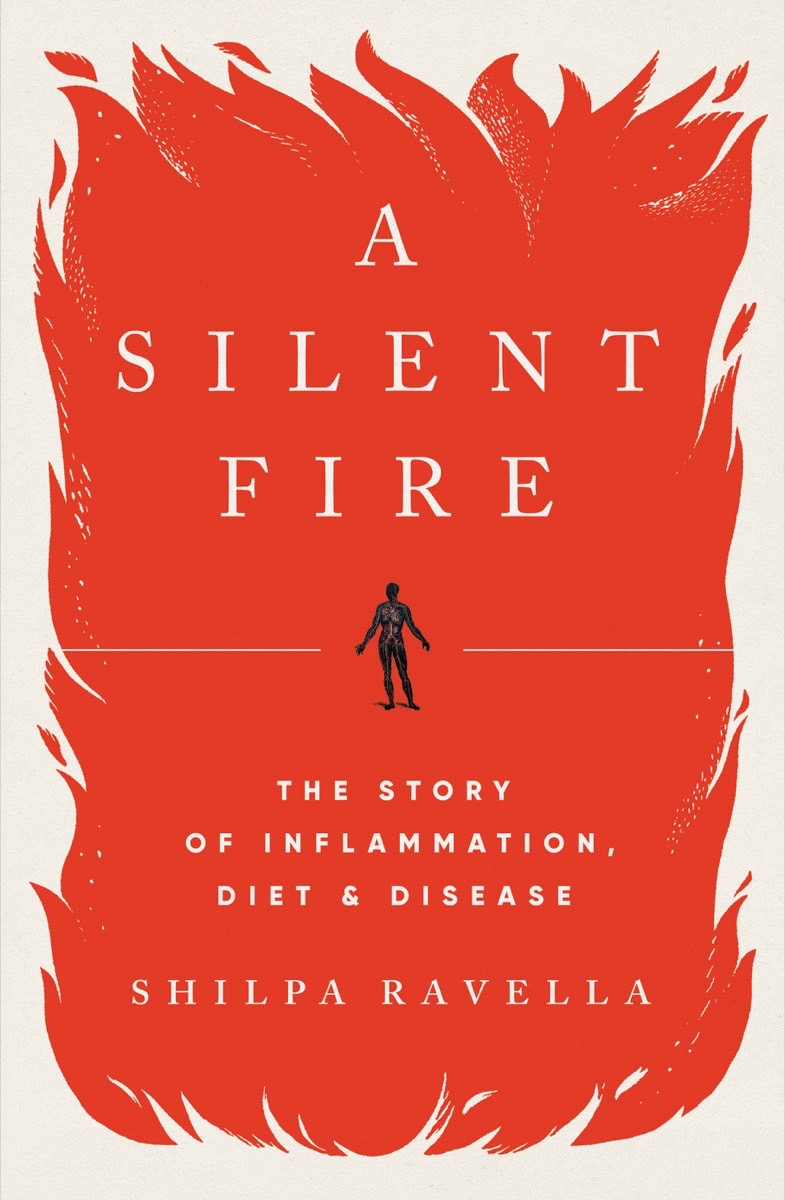Contents
Guide
Pagebreaks of the Print Version
Further praise for A Silent Fire
Shilpa Ravella paints a captivating portrait of one of our bodys most ingenious and intimate acts, sharing the formidable force of inflammation within us all. The way she charts forward is spot-on: curbing the rampant plague of modern maladies calls for diets and doctoring that protect the human body and its intrinsic power to keep us well.
Anne Bikl, coauthor of The Hidden Half of Nature and What Your Food Ate
Shilpa Ravellas fascinating, poetic exploration of the body, food, and history will sweep you up sentence by sentence. A book that could not only reshape readers understanding of their own systems and choices but possibly medicine itself.
Lauren Sandler, author of This Is All I Got
An enlightening dive into the medical science at the root of the modern epidemic of chronic diseasesand what it all means for healthy eating.
David R. Montgomery, coauthor of The Hidden Half of Nature and What Your Food Ate
A Silent Fire
__________________________
The Story of Inflammation, Diet, and Disease
SHILPA RAVELLA

This book is intended as a general information resource. It is not a substitute for professional medical advice. Seek immediate medical care if you experience symptoms like those described in this book. Patient names have been changed and identifying details changed or omitted; some patients are composites. The publisher is not responsible for, and should not be deemed to endorse or recommend, any website other than its own or any content that it did not create. The author, also, is not responsible for any third-party material.
Copyright 2022 by Shilpa Ravella
All rights reserved
First Edition
For information about permission to reproduce selections from this book, write to Permissions, W. W. Norton & Company, Inc., 500 Fifth Avenue, New York, NY 10110
For information about special discounts for bulk purchases, please contact W. W. Norton Special Sales at specialsales@wwnorton.com or 800-233-4830
acket design: Pete Garceau
Jacket art: (body) ilbusca / iStock Photo; (flames)
CSA-Printstock / iStock Photo
Book design by Lisa Buckley
Production manager: Anna Oler
Library of Congress Cataloging-in-Publication Data is available
ISBN 978-0-393-54190-8
ISBN 978-0-393-54191-5 (ebk.)
W. W. Norton & Company, Inc., 500 Fifth Avenue, New York, N.Y. 10110
www.wwnorton.com
W. W. Norton & Company Ltd., 15 Carlisle Street, London W1D 3BS
For FGR
Humanity has but three great enemies: fever, famine and war. Of these by far the greatest, by far the most terrible, is fever.
Sir Willam Osler
Disease usually results from inconclusive negotiations for symbiosis, an overstepping of the line by one side or the other, a biologic misinterpretation of borders.
Lewis Thomas, Lives of a Cell
They were nothing more than people, by themselves. Even paired, any pairing, they would have been nothing more than people by themselves. But all together, they have become the heart and muscles and mind of something perilous and new, something strange and growing and great. Together, all together, they are the instruments of change.
Keri Hulme, The Bone People
Contents
_____________
A Silent Fire
____________________
__________________
W hen we were medical students, my best friendwell call him Jaygave me a copy of Keri Hulmes The Bone People. Hulmes work is filled with isolation, fear, and violence. But at the core of this novel lies a love story, albeit one that distorts the notion of love so that it lives outside the margins of orthodoxy. The characters are figuratively stripped to the bone, their raw emotions bleeding through the page, juxtaposing the beauty and horrors of human nature. As we dissected cadavers that year, our surgical tools sliced through shallow and deep tissue, splitting soft gobs of yellow fat and tough, stringy muscle in an attempt to unveil and learn. The corpses on our tables, however, remained a mystery.
Nine years later, by the summer of 2012, Jay and I were living in Chicago. That July, a North American heat wave spread east from the Rocky Mountains, searing through the country with a ferocity unmatched since the 1930s. Highways in Illinois buckled under the pressure. In Grant Park, a large section of the pavement cracked and rose 3 feet into the air. I am haunted now by the audacity of that heat, and my own indifference to it, driving to and from work in a cool air-conditioned car. I wonder if, had I been dreaming less and watching more, things would have turned out differently.
It started insidiously, on a sweltering Friday evening. Jay had just returned from a workout at the gym. He made us a quick dinner of saucy linguine neatly nested in white plates. I remember how he escorted a spider from the windowsill out to the patio, setting it free. How he talked about escaping Chicagos sultry summers and frosty winters. Then, suddenly, he was tired. His fingers were cupped around his neck like he was going to choke himself. Something feels off, he told me. My neck is sore. I probably overdid it at the gym.
In the decade that I had known him, Jay was not one to complain about his health or even to ask for help when he was sick. I did not see any external injuries, and he could move his head freely. We chalked it up to muscle strain, a frequent sports-related injury that can cause local inflammation. He took some ibuprofen and expected to feel better soon.
A few weeks later, he was in worse shape. My head and neck feel heavy, like someone draped bulky blankets over them, he said. The muscles in the back of his neck had gotten weaker. Doctors ordered a magnetic resonance imaging (MRI) scan of his head and neck, which came back normal.
Two more weeks passed. As time flitted by, we watched in a slowly rising panic as Jays muscles continued to deteriorate. While driving home from work one day, he was barely able to lift his head up in order to gaze over the steering wheel. Soon, he developed a complete head drop and could not raise his chin off his chest. The moment at which this happened was hard to pinpoint. It was lost in a medley of moments both mundane and critical that we tried to sort through retrospectively.
At that point, Jay needed a body brace that extended to his waist. The brace was attached to a Philadelphia collar, a neck support used to prevent head and neck movement after a spinal cord injury. The contraption was uncomfortable, but it held his head up, redistributing its weight to the muscles in his middle and lower back. He took it off only if he needed to shower or sleep.
The average human head, which weighs about 10 pounds, is held up by a seemingly effortless, intricate balance among the muscles of the neck, an equilibrium so fluid and adept in its functions that one ceases to think about its mechanics. For Jay, that balance had been destroyed, suddenly and perhaps irrevocably. His condition continued to worsen. He was barely able to walk a few blocks before getting fatigued, and he started to have trouble swallowing food. The culpable force, whatever it was, had struck with terrifying speed and intention.
Doctors were baffled by the case. Jay was a young guy in his early thirties and had always been healthy. At first, neurologists considered a rare form of Parkinsons disease or the beginnings of amyotrophic lateral sclerosis, a rapidly progressive and fatal neurological condition in which nerve cells controlling the muscles degenerate. Patients lose the ability to move their arms and legs, swallow food, or speak. Muscles in the diaphragm and chest wall eventually fail, causing an inability to breathe. Within a few years, death ensues from respiratory failure.











